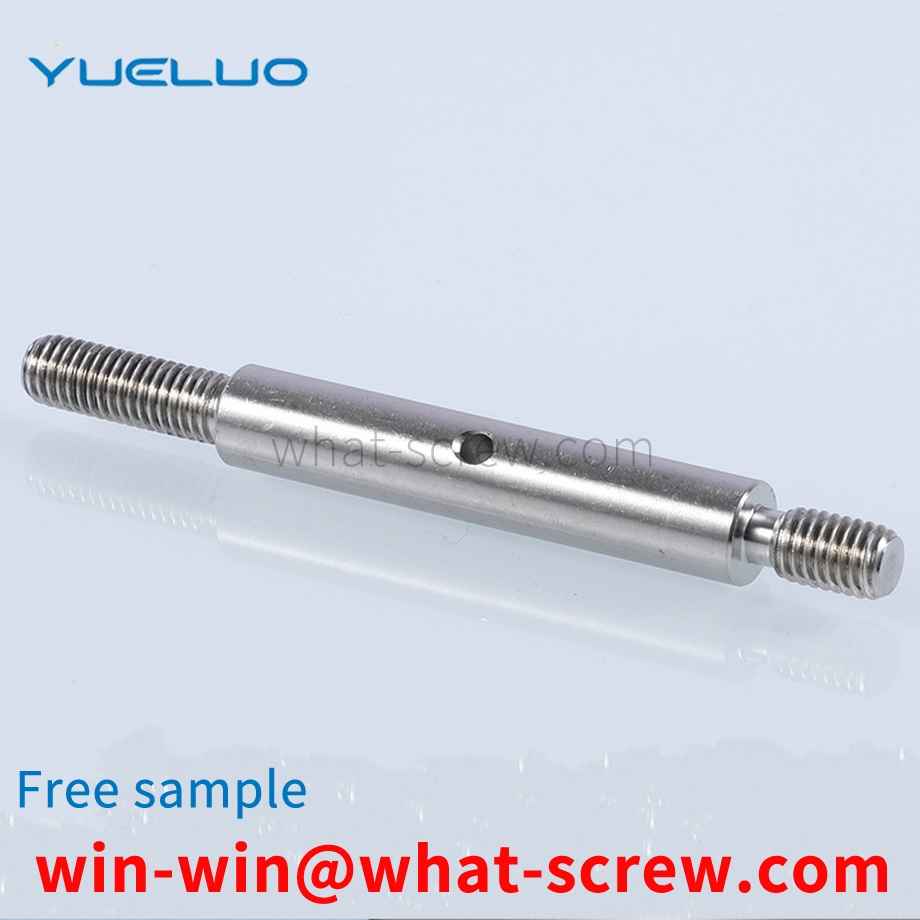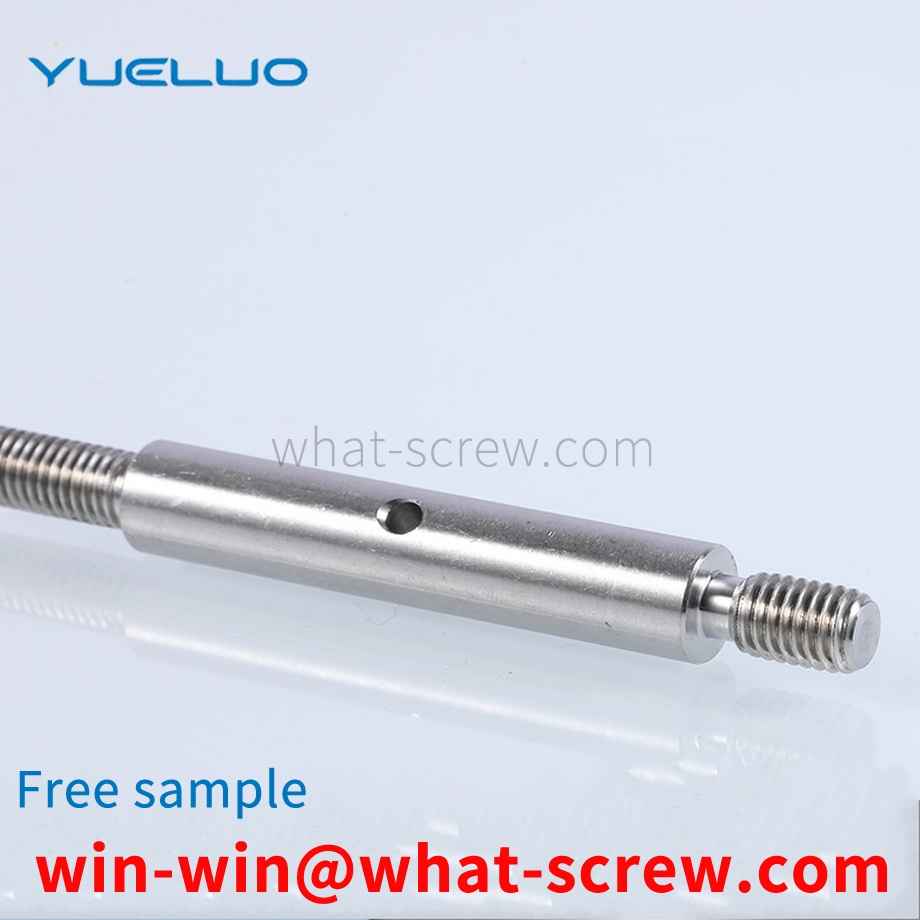The hinge is a hinge, which is often composed of two folds. It is a part that connects the two parts of the object and can make it move. The hinge supporting screws are installed on the corresponding objects. For different use environments, the requirements for the supporting screws are also different. different. Most of the existing screws are set to a single-threaded structure. When used to cut into a wooden door, the cutting speed is slow, and the cutting effect is not ideal, which is not conducive to cutting into a hard wooden door, etc., and the commonly used screws are often made of iron materials. It is easy to rust after contact with water vapor, reducing the service life; in addition, when the screw is driven into the wooden door, the chips generated cannot be discharged in time, and stay inside the wooden door and surround the screw, forming expansion stress, thereby squeezing the wooden substrate, which is not conducive to the screw. The connection with the wooden door is stable, which easily affects the normal installation of the hinge, and the use effect is poor. To sum up, in order to solve the shortcomings of the existing screw structure for hinges, Guangdong Yueluo Hardware Industry Co., Ltd. designed a hinge screw with simple structure, convenient use, fast construction and good effect.
Self-tapping screws were introduced into the industry in large numbers in 1914. The earliest design (essentially imitating a wood screw) was a thread-forming screw made of hardened steel with an A-ended end, mainly used to connect sheet metal channels for heating and ventilation systems. Therefore, it is also called: sheet metal screw. By the end of the 1920s, with the widening of the market and new applications, emphasizing new designs, its application performance was widely improved. The following introduces the four different stages of the development of self-tapping screws in 40 years: thread forming self-tapping screws, thread cutting self-tapping screws, thread rolling self-tapping screws and self-drilling self-tapping screws. 1. Ordinary self-tapping screws (thread forming self-tapping screws) Ordinary self-tapping screws are a direct product of early sheet metal screws. The principle is: when screwing it into a prefabricated hole, the internal thread connected to the screw is formed by the displacement of the material around the hole and the material is pushed into the space between the threads. 2. Self-cutting self-tapping screws (thread cutting self-tapping screws) Because ordinary self-tapping screws are formed only in very thin threads. And it can be easily realized on materials with good toughness. Develop and expand the use of self-tapping screws to thicker sections and harder, brittle and other materials with poor deformability. In this way, the self-cutting self-tapping screw is developed: a cutting groove or cutting edge is machined at the end of the screw shank. When this kind of screw is screwed into the prefabricated hole, the screw acts as a tap and actually cuts out the thread that connects with itself. 3. Self-Extrusion Self-Tapping Screws (Thread Rolled Self-Tapping Screws) In the early 1950s, fastener engineers began to recognize the potential advantages of self-tapping screws as structural rather than just lightly loaded attachments. This has led to the development of a new self-tapping screw thread rolling self-tapping screw (self-extrusion self-tapping screw). According to the design principle of cold forging taps, the thread and end are specially designed for this kind of screw, so that the screw can be formed by applying intermittent and periodic pressure on the crest of its thread instead of on the side of the entire thread. Internal thread for connection. By concentrating and limiting the forming pressure, the pressurized material next to the hole is made to flow more easily and to better fill (squeeze) into the flanks and roots of the thread of the self-tapping screw. Since the frictional resistance of screwing in is much lower than that of ordinary self-tapping screws, threaded rolling self-tapping screws (self-extrusion self-tapping screws) can be screwed into thicker sections. At the same time, it has better screw control and tightening torque, and greatly improves the connection strength and overall firmness. The engineering standard of this kind of self-tapping screw stipulates that the selection of materials, the mechanical properties of heat treatment and the working performance should be strictly controlled. 4. Self-drilling and self-tapping screws (self-drilling screws) People have done statistics: Among the ten expenses that constitute the total assembly cost, the highest one includes the processing of holes. In practical applications of self-tapping screws, prefabricated holes need to be processed. Moreover, in order to make the prefabricated holes have good effect in practical application, the size of these holes must be controlled within a fairly strict range. In the early 1960s, self-drilling and self-tapping screws appeared. A major step forward in reducing assembly costs by eliminating the need to machine prefabricated holes. In general, self-drilling and self-tapping screws realize drilling, tapping and tightening in one operation. These are the four main stages of self-tapping screw design and development. In addition, two newly developed products are also worthy of introduction. Both are screws with a special thread type. One is designed for plastic and other low-strength materials; the other is used in the construction industry to connect cement wall panels, so it is also called wall panel self-tapping screws.
With the rapid development of China's machinery industry, especially the development of heavy industry, the demand for large-scale metal processing equipment is increasing; at the same time, higher requirements are also placed on the technical parameters of the equipment. For some large-scale CNC equipment, to ensure the machining accuracy of the whole product, it is not only necessary to rely on high-performance components such as full closed-loop control and precision transmission components, but also requires the positioning and stability of the joint surfaces between the large and medium-sized components of the equipment. The common positioning of the joint surface between large components adopts flat key positioning, and this method requires processing the keyway at the joint surface of the large components. Since the joint surface of large parts is affected by factors such as processing and splicing, it cannot guarantee that the keyways on the large parts combined can be matched according to the theoretical requirements. Therefore, the positioning flat key needs to press the flat key in the two parts of large parts. Different repair allowances Trim into a stepped shape. The height difference of this keyway in different large components makes a single flat key need to be repaired on four sides, which increases the difficulty of the key repair process and makes it difficult to improve work efficiency. Not only that, when the flat key is repaired and assembled, it must be in an interference fit with the keyway, which makes the disassembly and assembly of the flat key more laborious.
The necked brake pad rivet includes a head and a shaft, the head and the shaft are integrally connected, and it is characterized in that: the head and the shaft are provided with axial through holes formed by cold heading, so The end of the shaft is provided with a tapered portion formed by cold extrusion and chamfering.
The technical problem to be solved by Yueluo is to provide a medical self-locking screw, which can fix the inner screw inside the outer screw, expand the outer screw head through the thimble on the inner screw, and use the outer cone on the inner screw. The body expands, compresses the surrounding bone, and achieves a double locking effect through the self-locking between the internal and external screws; it can hook the surrounding fixed parts when the anti-retraction ring is retracted to achieve the anti-regression effect; effectively prevent false implantation. After a long period of service, the looseness, fretting and other adverse reactions of the body are used to solve the defects caused by the existing technology.
We have many years of experience in the production and sales of screws, nuts, flat washers, etc. The main products are: aluminum alloy toothless hand-adjusting nuts, providing nuts, rope tensioner screws, nut sets with baffles and other products, we can provide you with The right fastener solution for you.



















 Service Hotline
Service Hotline




